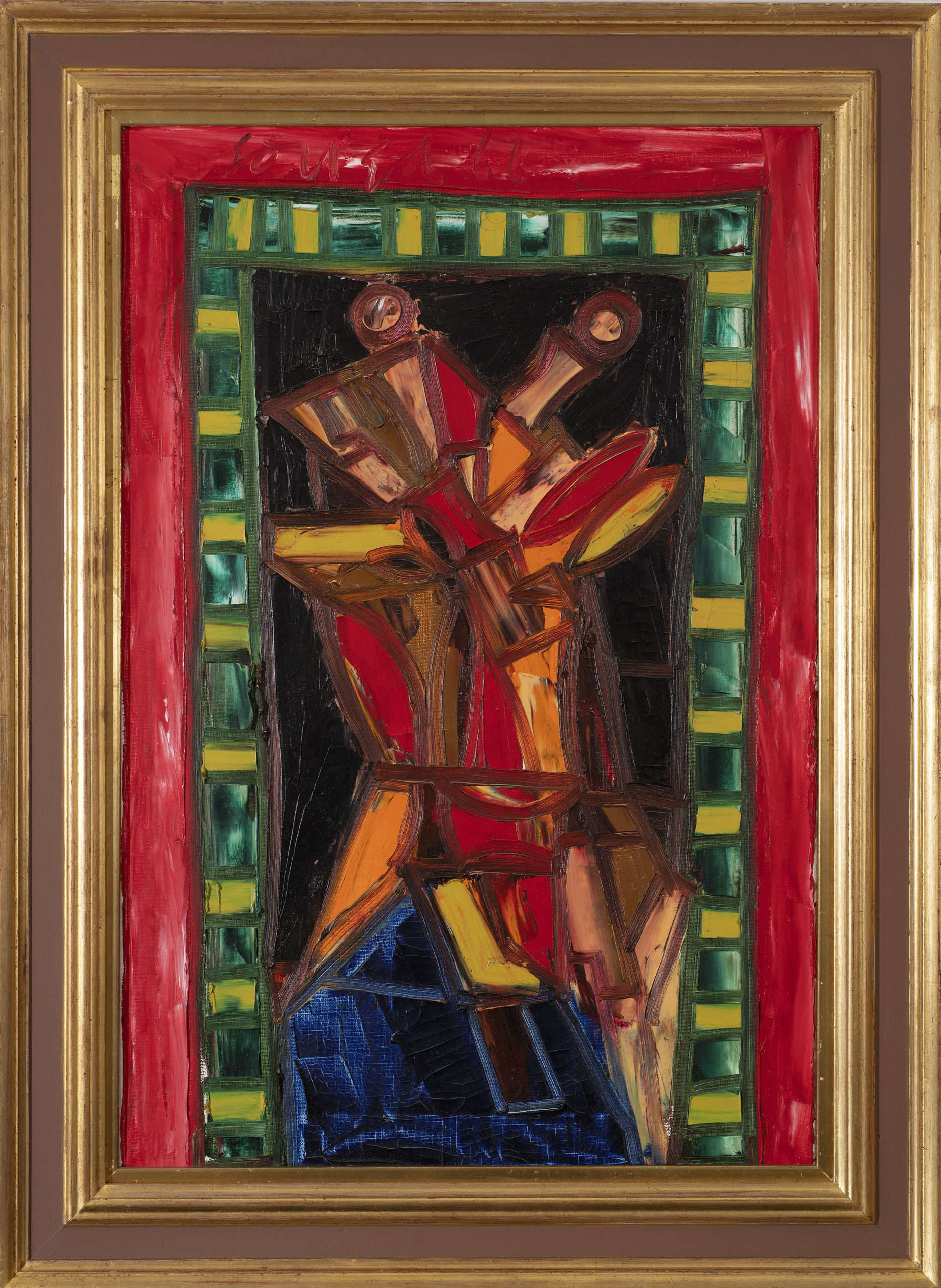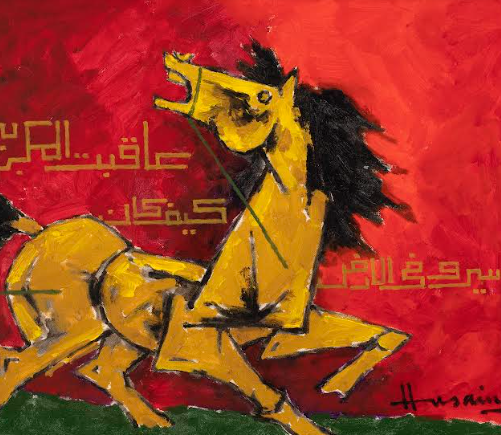Grosvenor Gallery from London celebrates the colour Red at Art Dubai 2023 with a suite of works that include 3 Indian Art Progressives Sayed Haider Raza, M.F.Husain and F.N Souza.

For years now the Gallery has continued to exhibit modern and contemporary South Asian art, predominantly the work of mid-20th century Indian modernists such as the Bombay Progressives, as well as Chughtai, Gulgee and Sadequain from Pakistan.The 3 Progressive Indian artists works talk to us about the power of colour and the depth and gravitas of compositional clarity that must accompany their sensibility which keeps them in their own class.
Souza’s Ask me Why 1966
F.N.Souza’s Ask me Why 1966 is a head with many colours and creates its own corollaries. Ask Me Why with a scarlet frame as well as red strokes in the centre is indeed an exemplar of Souza’s early grotesque style that drew the attention of friends and critics in London. The subject of the head in quarter length format is something that Souza loved creating .

His technique is reflective of his passion as he creates the head with a rich impasto broken with thick black lines revealing the mask like face with many elongated protrusions, reminiscent of African tribal masks. The expression is heightened with the few strokes and we see that his central focus is one of sheer dynamism and vitality.
The artist Francis Newton Souza has been a focus for the gallery, for years , his first show being The Human and the Divine Predicament (1964), followed by Black Art and Other Paintings (1966) followed by shows in 1998, 2001, 2002, 2005 at the Tate Britain in London and 2 shows in New York in 2005 and 2008.At Dubai this work is the cynosure of art lovers.
Sayed Haider Raza’s Bindu Diptyque 1992
Centurion artist Sayed Haider Raza’s Bindu Diptique is a masterpiece in myriad ways.Raza was seeking a new artistic direction, and turned to his homeland for inspiration. He made numerous visits to India, immersing himself in the metaphysical ideas of its historic texts. He began to render aspects of Indian cosmology with geometric shapes, the complementary forces of male (purush) and female (prakriti) energies for instance were represented by upright and inverted triangles.

Eventually, he adopted the bindu or a perfect black circle as a motif, which is now widely regarded as Raza’s trademark. This circle or bindu manifests itself in various forms throughout his oeuvre and is variously interpreted as a zero, drop or seed.. Formally, the Bindu is the principle around which Raza structures his canvases with this compositional construct having age-old precedents in meditative aids such as yantras and mandalas. Because black contains all other colours, Raza notes, “It is the inspiration of the black Bindu that lights up the colors, as if the light were springing from the darkness.” (M. Imbert, Raza: An Introduction to his Painting, New Delhi, 2003, p. 54)
MF Husain’s Horse
MF Husain’s Horse is a marvel that leaps out of the frame.Husain’s love for horses came from his childhood passion.

“For Husain, the horse was a combination of form, feeling and expression in uncanny ways as it embodied the passion of cosmic energies and stories of antiquity brought forward.
Maqbool Fida Husain’s horses are both personal and universal. They became a central part of his oeuvre since his first representation of the animal in the early 1950s, and are depicted as strong creatures, usually galloping, with reared heads and a tremendous sense of movement. Husain encountered the equine figure throughout his life across continents and cultures. He acknowledges the influence of Tang pottery horses and the paintings of galloping horses by Xu Beihong he studied on a trip to China, as well as the equestrian sculptures of the Italian artist Marino Marini, which he discovered during a trip across Europe. Horses also resonate with Husain’s admiration for Ancient Greece, a civilization that championed and deified the equestrian form. The Trojan Horse, Pegasus and Alexander’s prized Bucephalus are only a few iconic stallions that permeate the mythological and historical past of hallowed antiquity. In a conversation to me in 1999 he said: “ My horses belong to the beauty of a woman and the valour of man. In grace, in speed and in magnitude I created horses to celebrate time.”








